

5.4.1 Syntactic, morphosyntactic and morphological effects
I will refer to the property of A occurring on its own in an utterance as a "Syntactic effect" or "decompression effect" of the integration of A. The property of not being able to occur on its own but depending of another will be referred here as a "morphological effect". If a unit cannot function by itself in the utterance, it will be referred as a "morphemic unit" and if it can, a "syntactic unit".
| (11) | Utterance Independence | Utterance dependence |
 |
 |
I will refer to the property of A integrating with another B, allowing for an intervening C between B and C, as a "syntactic effect" or "decompression effect". This particular effect of discontinuity will be referred as "A and B integrate with a "weak bond"" (-). The property of not integrating with a weak bond will be referred as "strong bond" or "compression effect" (=).
| (12) | Weak bond | Strong bond |
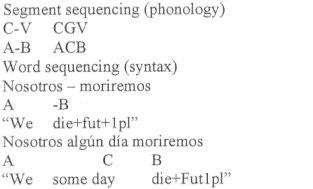 |
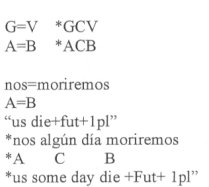 |
I will refer to the property of A integrating with B non-simultaneously as a "syntactic effect" or "Time decompression effect" (To (T+/-)). The property of A integrating with B simultaneously will be referred here as non-syntactic effect or "Time-compression effect" (To(To)).
| (13) | Non simultaneous | Simultaneous |
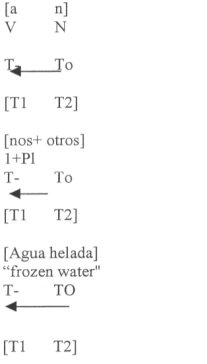  |
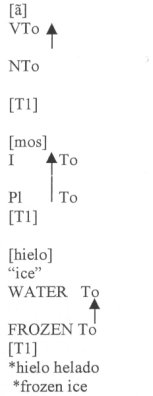 |
I will refer to the property of A integrating with B in a specific sequential order in time as strict order To(T+);To(T-);To(T+,T-). Clitics in Spanish when integrating with a Verboid (Verb, Gerund, Infinitive, Imperative) do not have in principle any strict order but this order becomes strict via the activation or inhibition of Tense associated simultaneously with the Verboid. If the Verboid has an activated Tense [+Tense], then the clitic integrates preceding the Verb, if the Verboid has an inhibited Tense [-Tense] (Gerund, Infinitive, Imperative), then the clitic integrates following the Verboid.
In phonology the Vowel does not have any element which helps to regulate order.
| (14) | a. Strict order of G | b. Non strict order of G |
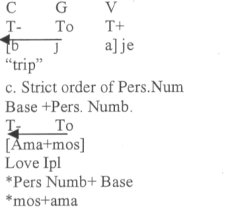 |
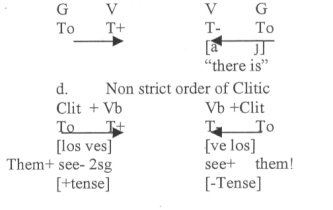 |
I will refer to A integrating with B with a "morphosyntactic effect" or "semicompression effect" when A is a morphemic unit which has no strict order and has strong bond with B.
A "morphological effect" or "compression effect" will be that produced by a morphemic unit A which integrates with B with strict order and strong bond.
To differentiate morphosyntactic strong bond from morphological strong bond I will refer to the morphosyntactic bond as semistrong (=) bond and the morphological bond as strong (==).
| (15) | |
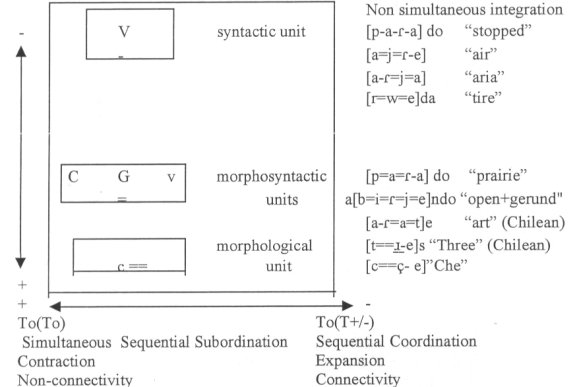 |
In (15), elements integrate in a compressed (+) or decompressed state (-) on the vertical and horizontal dimension. A Vowel [i] is a Vocoid in a decompressed state (Vowel Category) compared to a Glide [j], which is also a Vocoid, but is perceived in a more compressed state as a Glide category, integrating non simultaneously as dependant on the V. A svarabhakti category is a Vocoid in a more compressed state than the Vowel or the Glide. It is perceived as dependent of a Vocoid. The I+Pl as a Nominoid can be perceived as a syntactic NP [nosotros] "we" combining with a syntactic Verboid [nosotros+morimos] "we die", or a syntactic Det possessive [nuestra] combining with a syntactic Nominoid [nuestra+muerte] "our death", or as a morphosyntactic Clitic [nos] "us" combining with a syntactic Verboid [nos+morimos] "us die" or as a morphological desinence [mos] combining with a morphological verboid [mori+mos] "die we". When two elements integrate to form a timed sequence, the horizontal dimension in (15), they can be regulated to sequence in a time-compressed state (contraction), ranging from simultaneous To(To)(+) to non simultaneous To(T+), To(T-), To(T+,T-)(-). The effect when the integration is towards simultaneity is the "grammaticalisation or lexicalisation effect", also called "synthetic effect", and when integration is towards non-simultaneity, it is the "syntactic or morphosyntactic effect", also called "analytical effect".
For instance, Spanish periphrastic posterity: [tu-has de-morir] "you have to die" is produced with a time-decompressed integration. Here, posterity is expresssed combining an auxiliary verboid P2: [has-de] (have+[-Past]+2sg+Preposition) combining syntactically with a Verboid, P1(A), in Infinitive form [mori+r] (die+infinitive). The Argument of P1, the entity which has the property P1, is expressed as a syntactic unit [tu] "you". In this state of integration the element of posterity is quite free with respect to P1 and to the argument of P1: has tú de morir/has de morir tú.
Posterity P2 can also modify a P1(A) and be expressed in a synthetic way "DIE==POSTERITY==TENSE===PERSON": P1==P2==A [mori+r+á+s] (see 8i). This posterity modification of an event is integrated with a time-compressed integration, since now P1: DIE is a morpheme, P2: POSTERITY is another morpheme, and A: PERSON is another morpheme.
The Posterity P2 element can be expresed as a morphosyntactic unit [haber de] or as a morphological unit [r]. The effect is morpho-syntax for the former, since [haber de] is not a syntactic unit, although P1 and A are syntactic units, under the test, and morphology for the latter since none of its parts are syntactic units under the same test. When integration towards a timed sequence is non simultaneous, it is the "syntactic efffect" or "analytical effect" which is perceptually produced. Integration can consequently produce one element, P2 or I+Pl, to be integrated as a syntactic unit or morphosyntactic or morphological from the vertical dimension in (15). The more elements integrate as syntactic units the more they are "coordinated" or "juxtaposed", or "adjoined" producing effects of lose bonds, unordered sequences, expansion; the more they integrate as morphemic units the more they are "embedded", or "complementary of some other element" producing effects of strong bonds, ordered sequences, contraction in the time sequence which is here expressed as the horizontal line in (15). Integration on the horizontal dimension in (15) can produce mixtures of compression-decompression once some elements integrate simultaneously with others and some other elements non simultaneously with others, as we will see below.
In the Spanish phonological system the Rhotic element combines simultaneously with a Consonantoid C, [R-C], and stabilises non-simultaneously with a Vocoid V which is a Vowel category (15). Its Flap resolution, [R], derives from a stabilisation with two Vowels, [a-R-a], [a=j=R-e], [a-R=j=a], or a Vowel and a svarabhakti [p=a=R-a]do, [a-R=a]te. Syntactically it integrates with at least one V. If so, then a Glide can interfere in between. It can also integrate morphosyntactically with a svarabhakti. Rhoticity in Spanish will not combine with a Vocoid from a preceding syntactic or morphosyntactic unit, but it may stabilise with a Vowel from a following morphosyntactic or syntactic unit and resolve then as a flap. Its trill resolution, [r], derives from its integration with only a following V. The trill integration with the following V is syntactic since a Glide can interrupt it: [r=w=e]da (15). In its fricative resolution in Castilian, [®], it integrates always with V preceding [a==®] "military order", but can integrate with another element following [a==®==t]e. In Chilean dialects Rhoticity may integrate with a preceding Obstruency forming one affricate morphological unit which can only integrate syntactically with a following Vocoid (Lipsky 1994). The voiceless palatal affricate [c==ç] is a morphological unit according to this system since order is strict *[çc], each element is a morphological unit, and their bond is strong.
Under this approach the integration of P1, P2 and P3 can be said to have both a syntactic and a morphosyntactic integration. I will refer to the Glide as P4.
| (15') | P1- | A | Syntactic | Obstruent |
| (P1)=P2 | Morphosyntactic | Rhotic | ||
| P3-P2- | A | Syntactic | Rhotic | |
| P1=P3=P2 | Morphosyntactic | svarabhakti | ||
| P2=P4= | A | Morphosyntactic | Glide |
Volumen 22 (2005) ISSN: 1139-8736 |